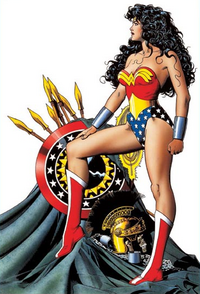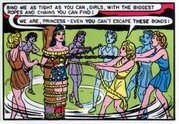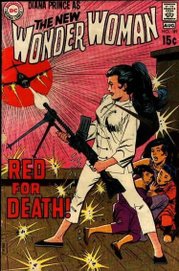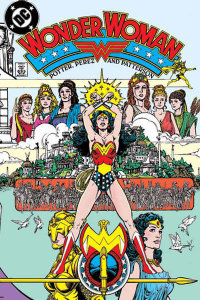She was one of the first female superheroes and is still arguably the most famous.
In most adaptations, Wonder Woman is Princess Diana of the Amazon warrior tribe of Greek mythology. Diana, however, is the Roman name for the Greek goddess on whom this character is based; Artemis is her Greek name. The Amazon ambassador to the larger world, she possesses several superhuman abilities and gifts from the Greek Gods, including the Lasso of Truth, created from the Golden Girdle of Gaea and indestructable silver bracelets, formed from the Shield of Aegis. She is also a member of the all-star Justice League.
Marston designed Wonder Woman as a distinctly feminist character and many subsequent writers, especially those of the 1980s and afterwards, have written her as such.
Outside the comic book community, she is known for a popular, although often campy, television adaptation which starred Lynda Carter and aired from 1975 until 1979. She has also been featured on the all-star animated series Super Friends in the 1970s and 80s and Justice League in the 2000s.
Her origin and her creator
William Moulton Marston was an educational consultant in 1940 for Detective Comics, Inc. (now known as DC Comics). Marston saw that the DC line was filled with images of super men such as Green Lantern, Batman, and their flagship character Superman. Seeing all these male heroes, Marston was left wondering why there was not a female hero.
Thus inspired, Marston developed the character of Wonder Woman with his wife Elizabeth (Sadie) Holloway Marston who served as the partial model for this unconventional and liberated woman. The other inspiration was found in Olive Byrne, an equally unconventional individual, who lived with the couple in a polygamous/polyamorous relationship.
Marston then introduced the idea to Max Gaines (then head of DC Comics) who was intrigued by the concept and told Marston that he could create the female comic book hero—a Wonder Woman. Marston did that, using a pen name that combined his own middle name with the middle name of Gaines: Charles Moulton.
Marston was also the creator of the systolic blood-pressure test, which led to the creation of the polygraph (lie detector). From this work, Marston had been convinced that women were more honest and reliable than men, and could work faster and more accurately. During his lifetime, Marston championed the causes of women of the day.
In a 1943 issue of The American Scholar, Marston said:
- "Not even girls want to be girls so long as our feminine archetype lacks force, strength, and power. Not wanting to be girls, they don't want to be tender, submissive, peace-loving as good women are. Women's strong qualities have become despised because of their weakness. The obvious remedy is to create a feminine character with all the strength of Superman plus all the allure of a good and beautiful woman."
Early days
In December 1941, Wonder Woman made her debut in All Star Comics #8. Following this exposure in the second largest selling comic in DC's line, she was featured in Sensation Comics #1 (January 1942), and six months later in her own self-titled book (Summer 1942), making her the first super-heroine to have her own comic book. Until his passing in 1947, Dr. Marston wrote all of Wonder Woman's appearances. Artist H.G. Peter (previously best known for his Gibson Girl illustrations) drew the book, giving it a simplistic but identifiable "female" style that contrasted with other super-hero comic books of the day.
Armed with her bulletproof bracelets, magic lasso, and her Amazonian training, Wonder Woman was the archetype of the perfect woman from the mind of her creator, Dr. Marston. She was beautiful, intelligent, strong, but still possessed a soft side. At that time, her powers came from "Amazon concentration", not as a gift from the gods.
Wonder Woman's "magic lasso" was supposedly forged from the Magic Girdle of Aphrodite, which Queen Hippolyta (Wonder Woman's mother) was bequeathed by the Goddess. To make the lasso, the god Hephaestus had borrowed the Olympian belt, removed links from it, and forged the magic lasso from it. It was unbreakable, infinitely stretchable, and could make all who are encircled obey the commands of the wielder, most notably to tell the truth.
Wonder Woman was aided by the Holliday Girls (led by the Rubenesque, sweets-addicted Etta Candy), who were a sorority that would help Wonder Woman in a time of emergency, or vice versa. Based partly on comedian Hugh Herbert, Etta was the only member of the Holliday Girls who stood out, with her distinctive figure and propensity for saying "Woo-woo" all the time, and was - after Steve Trevor and Diana herself - the most lasting character in the series.
Images of men putting women into bondage commonly appeared on the covers of Sensation Comics and Wonder Woman from 1942 to 1947. In Wonder Woman issue #3, it is Wonder Woman herself who takes the dominant side, tying other women up, and, in one memorable scene, dressing them up in deer outfits and chasing them through the forest, only to tie them up later and display them on a platter. This subtle, yet identifiable, sexual subtext to the book has been noted by comic book historians, who have debated whether it was an outlet for Dr. Marston's own sexual fantasies (recent biographies indicate that he was an avid practitioner of bondage); or whether it was meant (unconsciously or otherwise) to appeal to the developing sexuality of young readers.
During this same early period, Wonder Woman joined the Justice Society of America as its first female member. The Justice Society was the first super-team, featured in All Star Comics, and times being what they were, Wonder Woman, despite being one of the most powerful members, was the group's secretary.
Read more at Wikipedia.org





